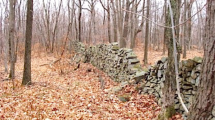Gamma ray logging is a method routinely employed by geophysicists and environmental engineers in site geology evaluations. Modelling of gamma ray data from individual boreholes assists in the local identification of major lithological changes; modelling these data from a network of boreholes assists with lithological mapping and spatial stratigraphic correlation. In this paper we employ Bayesian spatial partition models to analyse gamma ray data spatially. In particular, a spatial partition is defined via a Voronoi tessellation and the mean intensity is assumed constant in each cell of the partition. The number of vertices generating the tessellation as well as the locations of vertices are assumed unknown, and uncertainty about these quantities is described via a hierarchical prior distribution. We describe the advantages of the spatial partition modelling approach in the context of smoothing gamma ray count data and describe an implementation that may be extended to the fitting of a more general model than a constant mean within each cell of the partition. As an illustration of the methodology we consider a data set collected from a network of eight boreholes, which is part of a geophysical study to assist in mapping the lithology of a site. Gamma ray logs are linked with geological information from cores and the spatial analysis of log data assists with predicting the lithology at unsampled locations.
Similar content being viewed by others
REFERENCES
Besag, J., York, J. C., and Molliè, A., 1991, Bayesian image restoration, with two applications in spatial statistics (with discussion): Ann. Inst. Stat. Math., v. 43, no. 1, p. 1–59.
Clayton, D. G., and Kaldor, J., 1987, Empirical Bayes estimates of age-standardized relative risks for use in disease mapping: Biometrics, v. 43, no. 3, p. 671–681.
de Berg, M., van Kreveld, M., Overmars, M., and Schwarzkopf, O., 2000, Computational geometry: Algorithms and applications, 2nd ed.: Springer-Verlag, Berlin, 367 p.
Dellaportas, P., Forster, J. J., and Ntzoufras, I., 2002, On Bayesian model and variable selection using MCMC: Stat. Comput., v. 12, no. 1, p. 27–36.
Denison, D. G. T., Adams, N. M., Holmes, C. C., and Hand, D. J., 2002, Bayesian partition modelling: Comput. Stat. Data Anal., v. 38, no. 4, p. 475–485.
Denison, D. G. T., and Holmes, C. C., 2001, Bayesian partitioning for estimating disease risk: Biometrics, v. 57, no. 1, p. 143–149.
Diggle, P. J., Tawn, J. A., and Moyeed, R. A., 1998, Model-based geostatistics (with discussion): J. R. Stat. Soc.: Ser. C (Appl. Stat.), v. 47, no. 3, p. 299–350.
DiMatteo, I., Genovese, C. R., and Kass, R. E., 2001, Bayesian curve fitting with free-knot splines: Biometrika, v. 88, no. 4, p. 1055–1071.
Dirichlet, G. L., 1850, Über die Reduction der positiven quadratischen Formen mit drei unbestimmten ganzen Zahlen: J. Reine u. Angew. Math., v. 40, no. 4, p. 209–227.
Ellis, D. V., 1987, Well logging for earth scientists: Elsevier, New York, 532 p.
Fernández, C., and Green, P., 2002, Modelling spatially correlated data via mixtures: A Bayesian approach: J. R. Stat. Soc., Ser. B (Stat. Methodol.), v. 64, no. 4, p. 805–826.
Ferreira, J. T. A. S., Denison, D. G. T., and Holmes, C. C., 2002, Partition modelling: Technical report: Department of Mathematics, Imperial College, London, available at http://stats.ma.ic.ac.uk/~dgtd/tech.html.
Gilks, W. R., Richardson, S., and Spiegelhalter, D. J., eds., 1995, Markov Chain Monte Carlo in practice: CRC, Boca Rotan, FL, 512 p.
Green, P., 1995, Reversible jump Markov chain Monte Carlo computation and Bayesian model determination: Biometrika, v. 82, no. 4, p. 711–732.
Green, P., and Richardson, S., 2002, Hidden Markov models for disease mapping: J. Am. Stat. Assoc., v. 97, no. 460, p. 1055–1070.
Hastings, W. K., 1970, Monte Carlo sampling methods using Markov Chains and their applications: Biometrika, v. 57, no. 1, p. 97–109.
Hearst, J. R., Nelson, P. H., and Paillet, F. L., 2000, Well logging for physical properties: Wiley, New York, 483 p.
Heikkinen, J., and Arjas, E., 1999, Modeling a Poisson forest in variable elevations: A nonparametric Bayesian approach: Biometrics, v. 55, no. 3, p. 738–745.
Kass, R. E., and Wasserman, L., 1995, A reference Bayesian test for nested hypotheses and its relationship to the Schwartz criterion: J. Am. Stat. Assoc., v. 90, no. 431, p. 928– 934.
Knorr-Held, L., and Rasser, G., 2000, Bayesian detection of clusters and discontinuities in disease maps: Biometrics, v. 56, no. 1, p. 13–21.
Leonte, D., Nott, D. J., and Dunsmuir, W. T. M., 2003, Smoothing and change point detection for gamma ray count data: Math. Geol., v. 35, no. 2, p. 175–194.
McCullagh, P., and Nelder, J. A., 1989, Generalized linear models, 2nd ed.: Chapman and Hall, London, 511 p.
Metropolis, N., Rosenbluth, A., Rosenbluth, R., Teller, A., and Teller, E., 1953, Equation of state calculations by fast computing machines: J. Chem. Phys., v. 21, no. 6, p. 1087–1092.
Okabe, A., Boots, B., Sugihara, K., and Chiu, S. N., 2000, Spatial tessellations: Concepts and applications of Voronoi diagrams, 2nd ed.: Wiley, Chichester, England, 696 p.
O'Rourke, J., 1998, Computational geometry in C, 2nd ed.: Cambridge University Press, Cambridge, UK, 376 p.
Schwarz, G., 1978, Estimating the dimension of a model: Ann. Stat., v. 6, no. 2, p. 461–464.
Voronoi, M. G., 1908, Nouvelles applications des parametres continus a la theorie des formes quadratiques: J. Reine u. Angew. Math., v. 134, no. 3, p. 198–287.
Author information
Authors and Affiliations
Corresponding author
Rights and permissions
About this article
Cite this article
Leonte, D., Nott, D.J. Bayesian Spatial Modelling of Gamma Ray Count Data. Math Geol 38, 135–154 (2006). https://doi.org/10.1007/s11004-005-9008-6
Received:
Accepted:
Published:
Issue Date:
DOI: https://doi.org/10.1007/s11004-005-9008-6




